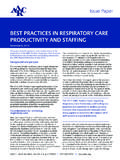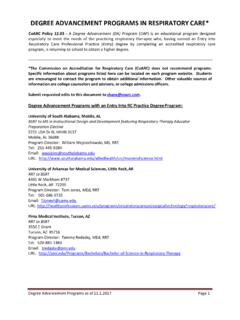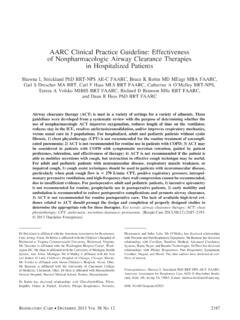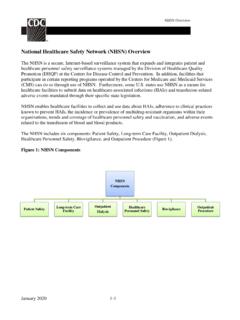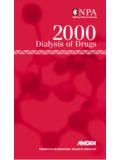Transcription of Coding Guidelines for Certain Respiratory Care Services ...
1 1 May 2020 Coding Guidelines for Certain Respiratory Care Services May 2020 (updates in blue) Overview As a service to our members, we developed Coding guidance for Respiratory care Services we are asked about most frequently. This guidance is based on the Medicare program s Coding and coverage policies, since it is the largest payer of health care Services and its policies are often used by private payers. Although this guidance is an informed opinion of Respiratory therapists and advisers who have experience and knowledge of codes and coverage policies, we suggest you verify the patient s eligibility and payer Coding requirements before providing a service as benefits are subject to specific plan policies which can vary among both public and private payers. Regardless of the setting, Respiratory therapists cannot bill any insurer directly for their Services . Difference between CPT Codes and HCPCS Codes Standardized Coding is essential for Medicare and other health insurance programs to pay claims for medically necessary Services in a consistent manner.
2 The Healthcare Common Procedure Coding Set (HCPCS), which is divided into two principal subsystems, is established for this purpose. HCPCS Level I is comprised of CPT (Current Procedural Technology) codes established, maintained, and registered by the American Medical Association (AMA). The CPT code set is the national Coding standard for physicians and other qualified health care professionals to report medical Services and procedures for billing public or private health insurance programs. HCPCS Level II is a standardized Coding system used primarily to identify products, supplies, and Services for which there are no CPT codes assigned. For example, these include drugs, ambulance Services and durable medical equipment, prosthetics, orthotics, and supplies (DMEPOS) when used outside a physician s office. Understanding the National Correct Coding Edit (NCCI) Edits According to the Centers for Medicare & Medicaid Services (CMS), the National Correct Coding Initiative (NCCI) was developed to promote national correct Coding methodologies and to control improper Coding that leads to inappropriate payment of Part B claims.
3 The NCCI edits and policies are applicable to physician, ambulatory surgical center, and outpatient facility Services . The Coding policies are based on Coding conventions defined in the American Medical Association's Current Procedural Terminology (CPT) Manual, national and local Medicare policies and edits, Coding Guidelines developed by national societies, standard medical and surgical practice, and/or current Coding practice. NCCI includes three types of edits: NCCI Procedure-to-Procedure (PTP) edits, Medically Unlikely Edits (MUE), and Add-on Code Edits. 2 May 2020 PTP edits prevent inappropriate payment of Services that should not be reported together. NCCI PTP edits are utilized by Medicare claims processing contractors to adjudicate provider claims for physician Services , outpatient hospital Services , and outpatient therapy Services ( , physical therapy, occupational therapy, and speech pathology). Medically Unlikely Edits (MUEs) prevent payment for an inappropriate number/quantity of the same service on a single day.
4 An MUE for a HCPCS/CPT code is the maximum number of units of service (UOS) under most circumstances reportable by the same Add-on code edits consist of a listing of HCPCS and CPT add-on codes with their respective primary codes. An add-on code is eligible for payment if and only if one of its primary codes is also eligible for payment. General Information about Medicare There are four distinct parts to the Medicare program. The AARC s Coding guidance focuses on coverage and Coding policies related to Respiratory care Services covered under Medicare Parts A and B which are discussed in greater detail below. Part A Inpatient Services such as acute care, hospice care, and skilled nursing facilities Part B Outpatient Services such as physician visits, clinics, free standing sleep labs, durable medical equipment (DME), etc. Part C Medicare Advantage ( , managed care) Part D Prescription drug coverage Inpatient Hospital Reporting of Actual Services under Medicare Part A Hospitals are paid under a prospective payment system in which items and Services provided to hospital inpatients are categorized into a diagnosis-related group (DRG) regardless of the number of conditions treated or Services provided.
5 The payment rate for each DRG is based on the average resources used to treat Medicare patients in that DRG and are paid under the Inpatient Prospective Payment System (IPPS) based upon DRGs. Codes for individual Services provided by Respiratory therapists during an inpatient hospital stay are not separately billed but are maintained in the facility s finance department. Payment of Outpatient Hospital Services under Medicare Part B Hospitals provide two distinct types of Services to outpatients: Services that are diagnostic in nature and Services that aid the physician in the treatment of the patient. With a few exceptions, hospital outpatient departments are paid under an outpatient prospective payment system (OPPS), although there are some Services that can be paid under a fee schedule. While inpatient Services are paid under the IPPS as noted above, outpatient Services are bundled into what are called Ambulatory Payment Classification (APC) groups. Services within an APC are similar clinically and with respect to hospital resource use.
6 Each HCPCS Code 3 May 2020 that can be paid separately under OPPS is assigned to an APC group. The payment rate and coinsurance amount calculated for an APC apply to all Services assigned to the APC. Physician office or clinic-based Services under Medicare Part B In a physician office or clinic setting, Respiratory therapy Services are furnished incident to the care provided and ordered by a physician (or placed in an approved protocol). The physician bills Medicare directly as appropriate, not the RT. To be covered, incident to Services must be: 1) commonly furnished in a physician s office or clinic (not an institutional setting); 2) an integral part of the patient s treatment course; 3) commonly rendered without charge or included in the physician s bill; and, 4) furnished under the supervision of a physician or other qualified health care professional. CPT Codes for Respiratory Care Ventilation Management including CPAP/Noninvasive Ventilation ( BiPAP) Ventilators used in the Emergency Department (ED) cannot be coded for subsequent days.
7 This includes instances where a patient expires in the ED or is transferred to another facility. However, if the patient in the ED is admitted as a hospital inpatient in the same facility, 94002 may be reported for the ventilator. Ventilation management CPT codes (94002-94004 and 94660) are not separately reportable with evaluation and management (E&M) CPT codes. If an E&M code and a ventilation management code are reported, only the E&M code is payable. There is no specific CPT code for noninvasive ventilation in the hospital setting, also referred to as Bi-Level Positive Airway Pressure. In these instances, some facilities use 94660 (CPAP) and some use Ventilator Management codes 94002 and 94003. Check with your Coding professionals for advice. 94002 Ventilation assist and management, initiation of pressure or volume preset ventilators for assisted or controlled breathing, hospital inpatient/observation, initial day 94003 hospital inpatient/observation, each subsequent day 94004 nursing facility, each day (Do not report 94002-94004 in conjunction with Evaluation and Management Services 99201-99499) 94660 Continuous positive airway pressure ventilation (CPAP), initiation and management 4 May 2020 Exercise Testing and the Six-Minute Walk Test It is appropriate to use the six-minute walk test code to evaluate distance, dyspnea, oxyhemoglobin desaturation, and heart rate.
8 Heart rate, blood pressure, oxygen saturation, and liter flow of supplemental oxygen are to be reported at rest, during exercise, and during recovery. Physician analysis of data and interpretation of the test are procedurally inclusive components of this code. 94618 Pulmonary stress testing; simple ( , 6-minute walk test), including measurement of heart rate, oximetry, and oxygen titration, when performed. To report exercise testing use: 94621 Cardiopulmonary exercise testing, including measurements of minute ventilation, CO2 production, O2 uptake, and electrocardiographic recording. To report an exercise test to determine the presence of bronchospasm use 94617. Administration of the bronchodilator by inhalation cannot be coded separately; the medication used can be coded as a supply. 94617 Exercise test for bronchospasm, including per and post spirometry, electrocardiographic recording(s), and pulse oximetry. Inhaler Techniques The following code is appropriate for demonstration and/or evaluation of inhaler techniques and includes demonstration of flow-operated inhaled devices such as Positive and Oscillating Expiratory Pressure (PEP/OPEP) devices.
9 The code may only be used once per day. For example, it cannot be billed at the same time/same visit as 94640. The code should not be reported for patients who routinely self-administer ( prior to their hospitalization). 94664 Demonstration and/or evaluation of patient utilization of an aerosol generator, nebulizer, metered dose inhaler or IPPB device can be used demonstrating (teaching) patients to use an aerosol generating device property. (94664 can be reported 1 time only per day of service) Inhalation Treatment for Acute Airway Obstruction CPT code 94640 describes treatment of acute airway obstruction with inhaled medication and/or the use of an inhalation treatment to induce sputum for diagnostic purposes. 5 May 2020 Hospital inpatient Services : If more than one inhalation treatment is performed on the same date of service, the code should be reported by appending modifier 76. If inhalation drugs are administered in a continuous treatment or a series of back-to-back treatments exceeding one hour, CPT codes 94644 and 94645 should be reported instead of CPT code 94640.
10 When providing inhalation treatment for acute airway obstruction, Medicare will not pay for both 94640 and 94644 or 94645 if they are billed on the same day for the same patient. The coder must decide which of the two codes to submit. Hospital outpatient Services , such as emergency departments: If inhalation treatments are administered in an outpatient setting, the use of CPT code 94640 is subject to NCCI edits which are described on pages 1 and 2 of these Guidelines . This means CPT code 94640 shall only be reported once during an episode of care regardless of the number of separate inhalation treatments that are administered. If CPT code 94640 is used for treatment of acute airway obstruction, spirometry measurements before and/or after the treatment(s) shall not be reported separately. It is a misuse of CPT code 94060 to report it in addition to CPT code 94640. The inhaled medication may be reported separately. An episode of care begins when a patient arrives at a facility for treatment and terminates when the patient leaves the facility.

